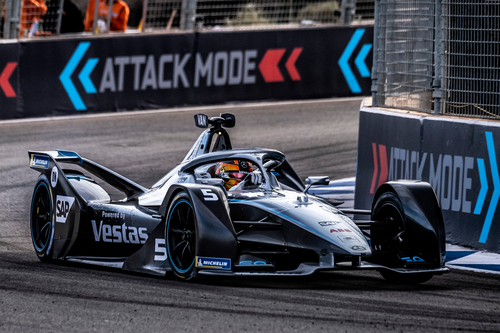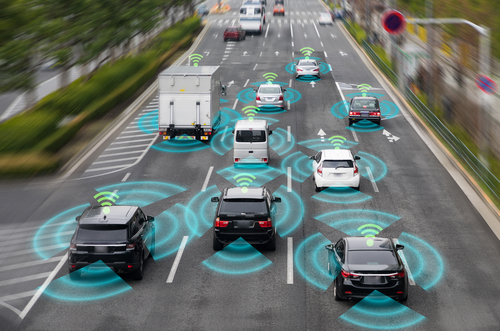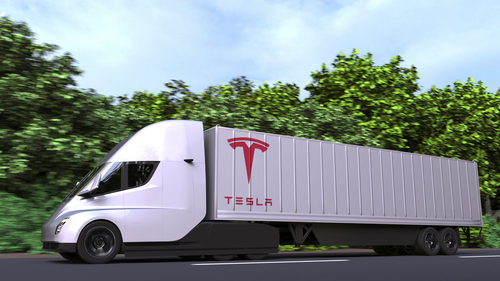EDUCATION
Artificial Intelligence, Electric Vehicles…and Flying Cars?
From The Drawing Board to The Dealer Showroom, the Future of Propulsion Is (Almost) Here
By Douglas McColloch

electric vehicle (EV) market and its potential impact on the
aftermarket. The verdict: Electrification will be the eventual standard
of vehicle propulsion, but it will take many years to happen, and its
biggest impediment for the near future is insufficient infrastructural
support, meaning lengthy charging times. Photo Courtesy:
Shutterstock.com
If there’s a topic that’s a greater subject of controversy in the automotive world at present than future tech, one would be hard-pressed to name it. By “future tech,” we’re referring to the increased production and popularity of electric and alternative-fuel vehicles; the explosive growth of advanced driver-assistance systems (ADAS) over the past decade and a half; how both of those market trends are influencing consumer behavior and driving the development of semi- and even fully autonomous vehicle (AV) propulsion systems; and how these developments will potentially impact the specialty-equipment aftermarket in the not-too-distant future.
A recent SEMA Education webinar titled “A.I., Electric Cars, Flying Cars and Other Unicorns” took a deep dive into the subject of future vehicle propulsion systems. Hosted by SEMA Director of Market Research Gavin Knapp, the webinar looked at electric and other alternative-fuel systems and the state of autonomous vehicle technology and their potential impacts on OE chassis and powertrain development for the next decade and beyond. What follows is a brief summation of the webinar.
EVs: Peas in the Ocean, but Growing in Number
To gain some perspective, Knapp first provided the lay of the land.
“There are more than 280 million vehicles on the road in the United States, and that’s just passenger cars and light trucks,” he said. “Obviously, there’s a lot more vehicles, large and small, than those worldwide. There are five times that many vehicles on the road, and newer vehicles dominate the road, right? We know that vehicles are now lasting 10 to 12 years.”
He also noted increased sales volumes for SUVs and CUVs over traditional cars as another trend to bear in mind.
On the other hand, he said, new cars are essentially computers on wheels, and the manufacturers are so reliant upon computerization now that “we’ve probably all heard in recent days about the microchip shortage that’s having OEMs shutter their plants and stop their assembly lines because they’re missing out on that little chip.”
“Because of that,” Knapp continued, “there are whole new branches of the auto ecosystem that are popping up—not just micro-electronics but also software and, of course, cybersecurity. Those are things that are really taking off within automotive and are going to flow through everything that happens with new cars moving forward.”
While electric vehicles (EVs) still constitute a minuscule market share of all new-vehicle sales, their numbers are expected to grow—and grow rapidly—in the coming years. A recent survey by global marketing firm IHS Markit found that new EV registrations in the United States had tripled during the period of December 2017 to December 2020. Based on that trend, the firm forecasted a market share of 3.5% by the end of 2021 and 10% by the end of 2025. While nearly 80% of all current EV registrations are of Tesla models, the proliferation of new platforms—including ever-popular pickups—from a growing number of automakers suggests a promising rate of growth in the segment in the years beyond.
“Ultimately, we expect the plug-in or the electric vehicle to take over,” Knapp said. “At this point, you’re starting from zero with electrics, but they are growing. That is a path the OEMs are going down. We’ve got GM, Ford, Volkswagen, Jaguar, Land Rover and Volvo all coming out with plans to spend multibillions of dollars to convert their fleets to electric over the next 15 years, so this is absolutely a path that’s happening, but it’s not going to happen tomorrow.”
In that vein, Knapp reminded that “even if we stopped making gas vehicles today and only made electrics, it would take us 20 years to replace all the gas vehicles on the road. And that’s not happening anyway, because the infrastructure is not there, especially for the batteries or for the companies to even be able to make that many electric vehicles right now. So even in an aggressive scenario, we’d be looking at fewer than half of the gas vehicles off the road in 20 years.”
Contextualizing further, Knapp noted that “even if you look at the peak sales of the Tesla Model 3 a couple of years ago, you’re still talking about half of what the [annual] sales of a Toyota Camry are.”

rolling showcase for the latest EV technologies on racing platforms,
with teams from Mercedes, Jaguar, Audi and Porsche heavily invested
in the series. This Mercedes-EQ entry piloted by Stoffel Vandoorne
enjoyed podium finishes in its first two races and was the pole sitter
at the 2019 Hong Kong Grand Prix. Photo courtesy: Shutterstock
If the Market’s so Small, Why Care at All?
As the variety of EVs expands beyond the purely utilitarian, their appeal to enthusiasts is likely to increase and in fact has already begun. Knapp used Tesla as a case study.
“They focused on the high-end upscale market, and they pushed performance as one of their selling points, as one of their brand offerings. If you don’t believe it, find somebody with a Model S and have them launch it. It’s a kick. And then, of course, the thing will park itself afterward.
“So expect to see a lot more push from those companies on the performance side and the enthusiast side as we go forward with new models—and not just giving you the Prius-type vehicles that we’ve seen in the past.
“Look at the Ford Mustang Mach-E that’s just been released. It will do 0–60 in 3.5 sec. That’s going to be more than enough performance for the general public and even for those who think of themselves as enthusiasts. The Mach-E also tops out at 300 mi. of range on a full charge, so that gets electric vehicles into that normal gas-car threshold. That alleviates a lot of the ‘range anxiety’ issues that came from earlier vehicles.”
Additionally, tax incentives such as those found in California can help bring down the prices of EVs to a more affordable range. The Mustang Mach-E “starts at $42,000, but there are still government incentives that could bring that down. If you’re in California, it can bring it down as much as $10,000,” Knapp observed. “That puts it into a pretty normal range, even though the cost of producing electrics is generally higher because of the battery technology.”
Challenges and Opportunities
While the future looks rosy for EVs, there are still some logistical roadblocks that will need to be cleared before they find wider acceptance among the general public. The first and most noticeable is charging time. Using the Mach-E as a benchmark, Knapp laid down a timeline.
“Using the supplied standard charger that you can plug into a 120-volt outlet, Ford estimates that it takes 95 hours to completely charge the vehicle—that’s four full days to charge,” he said. “So if you charge overnight, you can get 30 mi. of range. That’s probably good enough for your commute, but if you use it every day, you’re never going to get the thing fully charged.
“If you have access to a 240-volt outlet, you can get the charging time down to 15 hours, or a dedicated charger gets the charging time down to 11 hours—an overnight charge scenario. But a lot of people don’t have access to 240-volt outlets, especially if they live in apartments. If you live in some other building that requires you to park in a lot or on the street, charging options are not going to be good for you right now—and maybe charging at home is not an option at all.”
While public charging options have increased exponentially over the past decade with more than 16,000 charging stations nationwide now, Knapp noted that the number pales compared with the more than 120,000 gas stations in the United States.
“If you look at the map, the bigger issue is that there’s a lot of areas where there are no public charging stations,” he said. “Those empty areas are definitely a problem if we’re talking about widespread use of the vehicle and if you want to drive across the country.”
Even with those limitations, Knapp counseled against the aftermarket selling EVs short.
“You’ve looked at these issues facing electric cars and may be thinking, ‘Well, it’s only because of the hippies and the government that they’re doing this,’” he said. “I have to tell you, this is really largely about money and capitalism.”
Using Lordstown Motors as an example, Knapp laid down the bottom-line benefits to electrification.
“Lordstown Motors thinks its truck’s big benefit is that it has four electric motors, each one mounted at a wheel,” he explained. “There are no axles, no drivelines, no transmission and none of the thousands of other moving parts that need to be assembled in a typical gas-engine vehicle.
“If you’re a manufacturer, you have to look at that and say, ‘Wow, I can use fewer vendors. I can stock fewer parts. I can manufacture fewer parts, and I can very much simplify my assembly-line process by going down this type of path.’ I guarantee you that the OEMs are looking at that and saying, ‘We’ll invest now, but we will save a lot of money down the line once these electric vehicles come online.’”
Investors have also made it abundantly clear that they see electrification as the automotive wave of the future.
“Tesla sells a few hundred thousand cars per year, and yet they have a market cap of more than $600 billion,” Knapp explained. “The nearest other car company is Toyota at $200 billion—and Toyota sells 10 million cars a year—yet Tesla is still worth three times more. You look at GM, Ford—eight times multiple, 13 times multiple in terms of market cap, so when these companies are going into the electric vehicle market, they’re not just doing it to satisfy gas regulations, and they’re not just doing it to be green—they’re chasing the money.
“Even companies like Rivian, which hasn’t even delivered vehicles, is seeing multibillion-dollar investments and a $20 billion valuation. Some other companies you may not even have heard of have multibillion-dollar valuations. So keep that in mind when you’re thinking, ‘Oh, it’s just about going green, it’s just about government regulations.’ It’s about money, and if you follow the money, that is one of the reasons why I believe that electric is here to stay.”

reliably safe and predictable manner in typical traffic conditions, cars
on roads of the future will need to be “connected” and exchanging
operational data (such as ADAS data) with each other via a series of
wireless networks. That in turn will pose challenges to both in-vehicle
cybersecurity and external traffic management systems. For those
reasons (among others), fully autonomous self-driving passenger
cars are seen as still being a long way from widespread use among
the general public.
Potential for the Aftermarket
While the short-term crossover appeal to the specialty-equipment market may be small—1% of the overall market, Knapp estimated—the popularity of EVs will continue to grow as more OE manufacturers produce vehicles such as the Mach-E that are tailored to the performance enthusiast sector.
“They’re going to try to get enthusiasts on board to become their advocates for electric power,” he said. And the future of this market trend may very well be now.
“The place this is most likely to start, and what might be the tipping point to entice enthusiasts and to bring our industry on board, is all of the new electric trucks that have been announced,” Knapp surmised. “Look at GM. It took the name of the poster child for fuel-economy excess, the Hummer, and made an electric truck out of it. You’ve got the Tesla Cyber Truck and the Lordstown trucks that are coming out and, of course, the Jeep Wrangler 4xe that’s coming out.
“So while people are used to seeing the Prius types, companies are changing their tack, and they are going after the high end and the enthusiast community with electric vehicles, which means they’re coming after our space” [emphasis added].
Formula Drift and Ultra 4 racer Vaughn Gittin Jr. explained the enthusiast appeal of electrification in a recent interview with SEMA News.
“I’m a Mustang guy to my core, but the acceleration [in the Mach-E] is unbelievable,” he said. “Because of the low center of gravity, the handling is something like you’ve never felt in an internal-combustion car except for supercars. The battery is in between the axles, inches from the ground, and the car just turns. It feels unbelievable. I’ve been swayed, and my increased love and passion for electric and these technologies is a result of that.”

recently at the company’s facility in Fremont, California. Powered by
four electric motors and capable of a 5-second 0–60 time and a
claimed 500-mile range, the truck is scheduled to enter production
later this year. Preorders have already been received from companies
such as Frito-Lay, Walmart, Pepsi and Anheuser-Busch. Photo
courtesy: Shutterstock.com
AVs: Driving the More Distant Future
As with EVs, the market share for autonomous vehicles is expected to rise throughout the decade as more OE players and startups alike get involved in the segment, offering more makes and models for a greater variety of tasks and applications. A 2020 study by market research firm Market Digits forecasted substantial growth in market size for the sector, from $35 billion in global revenue in 2021 to $856 billion by 2027, with a compound annual growth rate of 58% during the period. While applications for passenger cars will remain limited for the near future, the study identified transportation (buses, cabs, etc.) and national defense as two promising industry growth sectors in the short term.
While many ADAS technologies that enable a degree of autonomous vehicle operation have already been adapted across the market—collision avoidance, automated brake assist, adaptive cruise control and self-park assist, to name a few—the realization of fully autonomous operation for OE production cars is still in the more distant future.
“I think GM had promised that we’re going to have a fleet of 50,000 autonomous vehicles on the road within the next four years,” Knapp recalled. “That was five years ago. It hasn’t happened.”
Still, as with EVs, the investment community, the OE manufacturers and the Silicon Valley tech companies have made it clear that they see autonomous vehicle technology as a viable growth market going forward.
“The biggest names in technology—companies with lots of money, such as Google, Microsoft, Apple and Amazon—are putting multi-billion dollar investments behind autonomous vehicles,” Knapp said. “Recent investments in [GM-backed] Cruise and [Google-owned] Waymo have shown them at valuations of $30 billion—and those are companies that have not produced any cars and, frankly, are quite a way from producing any road-going cars. But again, the money is following that technology.”
And the manufacturers are putting their platforms to the test. In California alone, Knapp noted, there are 63 companies that have permits to test AVs on public roads. Last year, 650 AV test vehicles reported mileage of almost two million combined miles.
Even with its current drawbacks, there are specific applications where AV technology could be employed before it becomes production-vehicle ready.
“Where we will see a lot more movement in the short term is with the special-use cases, such as a people mover,” Knapp said. “Basically, it’s a low-speed vehicle. It’s limited to a very specific area, like a parking lot at a university or a business park, and its object is to function like a small bus. People get on, get to where they’re going and get off. You’ve probably also seen those little drone autonomous delivery vehicles. They are coming too.
“Another area that seems to be a big push, which may be a little scary, is in long-haul trucking—basically the biggest vehicles on the road. It’s another area where people are predicting that autonomous driving may come early, at least for the highway portion of the route.”
Tesla, for one, is in the late testing stages of a Class 8 semi truck that is slated to enter production for preorder buyers later this year.
And Those Flying Cars?
For the foreseeable future, flying cars remain as they have been since they were envisioned in the ’40s and ’50s—an aspirational vehicle that’s still more embedded in theory than reality.
“We’re just not there yet,” Knapp admitted. “The space we’re in right now, there’s a lot of companies that are pushing out prototypes, who are pushing out hopes to do that, but most of the things coming out would be more like personal helicopters or large-scale drones. I think most companies are angling more for a commuter taxi type of setup rather than being actual cars that you drive and fly yourself. But while we’re not quite there yet, maybe someday we’ll have flying cars.”
About SEMA Education
 Accessing SEMA’s industry-leading education curriculum is easier than ever. With dozens of live and on-demand offerings—and more live-streaming during the year—SEMA Virtual Education includes comprehensive presentations and insightful discussions and videos that teach, inform and entertain automotive specialty-equipment professionals. Builders, engineers, marketers and sales staff can all become better educated and prepared for success through SEMA’s Virtual Education. Visit www.sema.org/virtual-education to learn more.
Accessing SEMA’s industry-leading education curriculum is easier than ever. With dozens of live and on-demand offerings—and more live-streaming during the year—SEMA Virtual Education includes comprehensive presentations and insightful discussions and videos that teach, inform and entertain automotive specialty-equipment professionals. Builders, engineers, marketers and sales staff can all become better educated and prepared for success through SEMA’s Virtual Education. Visit www.sema.org/virtual-education to learn more.







